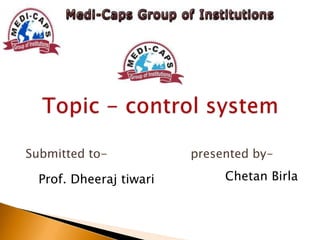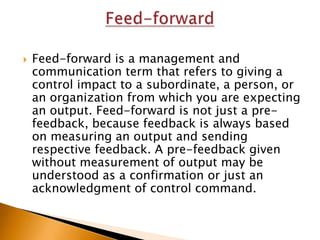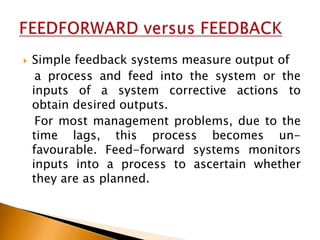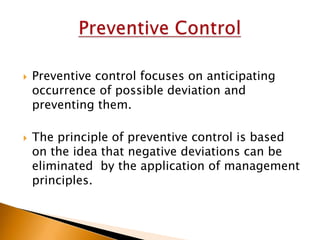control system , feed forward, preventive, profit & loss control& ROI.
- 1. Submitted to- Prof. Dheeraj tiwari presented by- Chetan Birla
- 2. ’üĮ Feed-forward is a management and communication term that refers to giving a control impact to a subordinate, a person, or an organization from which you are expecting an output. Feed-forward is not just a prefeedback, because feedback is always based on measuring an output and sending respective feedback. A pre-feedback given without measurement of output may be understood as a confirmation or just an acknowledgment of control command.
- 3. ’üĮ Feed forward is generally imposed before any wilful change in output may occur. All other changes of output determined with feedback may result from distortion, noise, or attenuation. Feed forward usually involves giving a document for review and giving an ex post information on that document that has not already been given. However, social feedback is the response of the supreme hierarch to the subordinate as an acknowledgement of a subordinate's report on output.
- 4. ’üĮ ’üĮ ’üĮ A model of the system should be developed. Care should be taken to keep the model dynamic. Data on input variables must be regularly collected and put into the system.
- 5. ’üĮ Simple feedback systems measure output of a process and feed into the system or the inputs of a system corrective actions to obtain desired outputs. For most management problems, due to the time lags, this process becomes unfavourable. Feed-forward systems monitors inputs into a process to ascertain whether they are as planned.
- 7. ’üĮ As we can see from the diagram above, Feed forward is actually like a reverse-feedback. As a result of this, the corrections can be made into the input side of Feed-forward system so that the output lies unaffected. On the other hand, it cannot be denied that even with a Feedforward control, a manger would still want to measure final system output since nothing can be expected to work perfectly enough to ensure that the final output will always be exactly to what it is right now.
- 8. ’üĮ ’üĮ Preventive control focuses on anticipating occurrence of possible deviation and preventing them. The principle of preventive control is based on the idea that negative deviations can be eliminated by the application of management principles.
- 9. ’üĮ ’üĮ ’üĮ Qualified managers make a minimum of errors The management fundamentals can be used to measure performance Application of management fundamentals can be evaluated
- 10. ’üĮ ’üĮ ’üĮ ’üĮ Greater accuracy is achieved in assigning personal responsibility. Preventive control encourages self-control and make corrective action more effective. Preventive control may lighten the managerial burden caused by direct controls. Employees may be motivated to improve themselves continuously.
- 11. ’üĮ A profit and loss statement shows a company's revenues and expenses for an accounting period. It also shows a profit or loss, which equals revenues minus expenses. A company with greater revenues than expenses generates a profit for the period, while a company with greater expenses than revenues generates a loss. A business wants to generate the most profits possible. While some of your profit and loss statement depends on the market and your customers, there are some items that you can control to increase your profits.
- 12. ’üĮ Audit financial information ’üĮ Limit access to financial information. ’üĮ Ethics training. ’üĮ Control inventory.
- 13. ’üĮ One of the most successfully used control techniques is that of measuring both the absolute and the relative success of a company or a company unit by the ratio of earnings to investment of capital. The returnon-investment approach, often referred to simply as ROI, has been the core of the control system of the Du Pont Company since 1919.
- 14. ’üĮ ’üĮ ’üĮ ’üĮ It measures the effectiveness of the company as the whole and of its measures devotional its product & planning. Can be used to compare divisions of different sizes. Acceptable/understandable Uses readily available accounting figures.
- 15. ’üĮ Can lead to dysfunctional decisions. ’üĮ Profits can be manipulated. ’üĮ It fails to focus attention on other important aspect of the enterprise of such as employ moral and employ development, public relation.
















